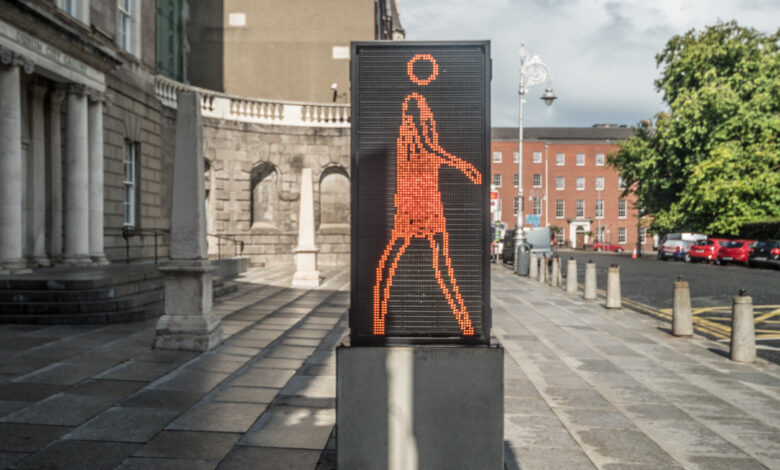Julian Opie and the Evolution of the Contemporary Sculptural Language

Julian Opie has a multidisciplinary track that encompasses painting, contemporary sculpture, digital art, and drawings. Opie’s work is inspired by a melding of diverse inspirations from classic portraiture to Japanese woodblock prints and his trademark led signage. His earlier works drew acclaim for their minimal yet evocative representations of people and set the groundwork for his investigation of sculptural simplicity and Modernism.
Opie became well-known for his strikingly simple yet instantly identifiable style, which featured strong lines, vivid colors, and simplified shapes. His artistic use of digital technology, including computer-generated graphics and LED works, demonstrates the smooth blending of conventional and avant-garde techniques. Opie’s work explores how digital tools may be used to portray complex narratives and emotions, engaging with the current discourse on the interface of art and technology. Opie’s work defies artistic standards and offers a captivating reflection on the changing nature of art in the twenty-first century by bridging the gap between the classical and the contemporary.
Opie’s signature portrait style is to strip complex forms down to their essential components, using bold lines and flat colors. This reductionist approach, which is often compared to the principles of Japanese woodblock printing, emphasizes Opie’s intention to reduce visual information to its core and create iconic and timeless representations. This reductionist spirit continues neatly into his sculptural work, where Opie incorporates multiple elements such as metal, sheet vinyl and light fixtures to achieve a sense of simplicity and purity.
A noticeable feature of Opie’s sculptural practice is his use of LED lights to outline figures and create an interplay between positive and negative space. His experimentation in technology not only lends a contemporary touch to his sculptures, but also functions as a commentary on the ubiquitous impact of technology on human cognition and interactivity.
Opie’s Sculptural Narrative: A Play of Form and Light
Opie’s sculptural works implicate the spectator in a dialog that obscures the lines between contemporary and traditional aesthetics. His LED sculptures, such as Sara Getting Out of Her Bath, explore the nature of motion and shape through a meticulous play of light. The conscious use of minimal strokes and geometrical forms converts the sculptures into dynamic, almost animated displays.
In “Sara Getting Out of Her Bath”, Opie encloses the human form in a sequence of LED outlines reminiscent of digital avatars. The stark plainness of the depiction coupled with the pulsating LED lights gives the static sculpture a sense of vitality and movement. This fusion of classical subjects with a contemporary execution embodies Opie’s ability to bridge historical contexts and invite the viewer to rethink their relationship with the past and present.
Opie’s Influence on Contemporary Sculpture
Julian Opie’s impact on contemporary sculpture goes beyond his individual works. His unique approach has challenged both artists and audiences to question preconceived notions of sculptural practice. By embracing classical and modern elements, Opie forges a unique path that encourages a reassessment of artistic conventionality.
Opie’s incorporation of technology, particularly LED lights, is indicative of the general trend in contemporary sculpture to embrace new media and materials. As technology continues to entwine with everyday life, artists like Opie are moving at this crossroads, producing works that not only reflect the spirit of the times, but also encourage contemplation on the developing nature of artistic representation.
Furthermore, Opie’s stress on simplicity and minimalism is in line with the broader contemporary art movement that distills complex ideas into accessible forms. In an age of overloaded information, Opie’s works offer a visual respite and invite the audience to explore art on a visceral level.
Contemporary Sculpture: Going Across Borders
Transcending the impact of Julian Opie, 21st century contemporary sculpture is continuing to evolve by adopting new media, cross-disciplinary practices and new conceptual frameworks. 21st century contemporary sculptors are exploring themes such as sustainability, the transience of art and the overlap between disciplines, contributing to a rich and diverse landscape.
Found-object sculpture, for example, challenges traditional notions of materiality by converting quotidian objects into art. This praxis is in line with Opie’s code of finding meaning in the ordinary and highlights a broader shift in contemporary sculpture towards a more inclusive and sustainable approach
Artists like Julian Opie encourage us to comprehend the dynamic nature of this art form as we traverse the intricate web of contemporary sculpture. Through the interplay of light, form and design, Opie’s sculptures transcend the conventional, challenging us to look beyond the surface and examine the unfolding narrative of contemporary sculpture.
Photo Credit: “SUZANNE MOVED FROM O’CONNELL STREET IN 2008 TO THE HUGH LANE GALLERY [ARTIST – JULIAN OPIE]-131327” by infomatique.
